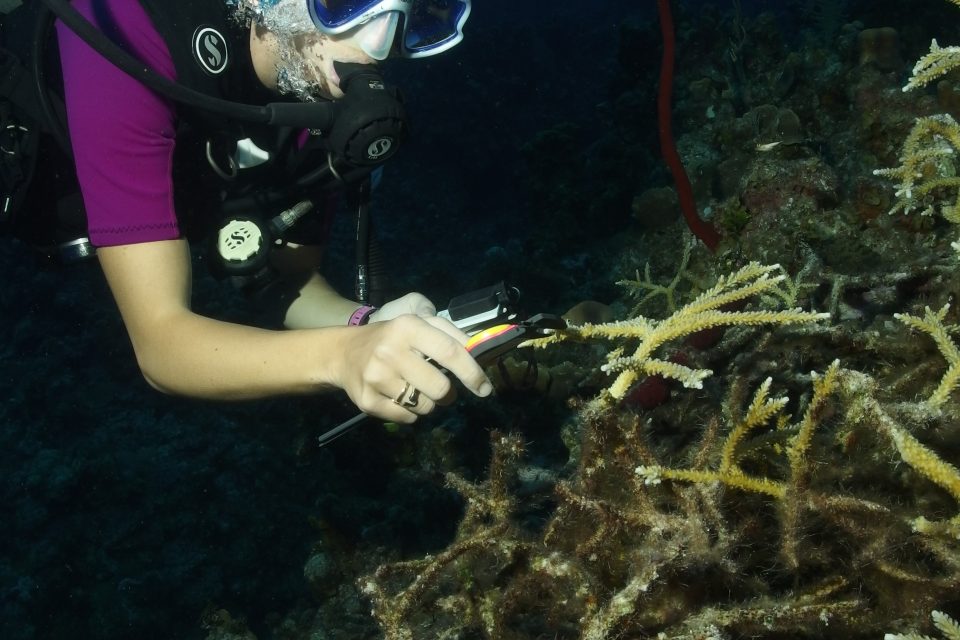Ocean Defender of the Week: Dr. Emma Camp
UW360 talks to Dr. Emma Camp about her amazing career and a call to arms to protect our reefs

As a marine biologist, a climate change scientist, and a coral reef researcher, Dr. Emma Camp‘s work takes her straight to the front-line. Her focus is on coral habitats – particularly “unsexy” ones like seagrass and mangrove systems. Aesthetics aside, and unbeknown to most, these habitats are the secret to finding out the future impact of climate change on coral reefs around the world. With her time balanced between hands-on field work and experiments back in the laboratory, Dr. Camp aims to unlock these secrets. Dr. Camp currently works as a Post-Doctorate Research Associate at the University of Technology Sydney. Over the past four years, she has been involved with Earthwatch and Operation Wallacea as a coral reef researcher, and is currently an ambassador for global biodiversity at the charity IBEX Earth. She has been awarded grants from the Women Diver’s Hall of Fame, National Geographic, and the French and Australian Governments for her research on marginal reef environments. She is also a PADI Dive Master with a passion for underwater photography.
What got you into marine bio-geochemistry?
I have always loved the ocean and even as a child I wanted to be a Marine Biologist. My specific focus area on coral reefs and climate change evolved overtime. I was given the opportunity to do a Ph.D. investigating how the chemistry of different marine habitats can influence the survival of resident corals, particularly considering the current and future threats of climate change. In order to complete this Ph.D., I had to learn about seawater carbonate chemistry, coral physiology and ecology: This evolved my speciality towards marine bio-geochemistry. In short, this means that I study how the biological and abiotic calcium carbonate structure of corals change under different seawater chemical conditions.
What are your main research interests?
My passion and research focus is exploring non-reef systems, such as seagrass habitats and mangrove systems that house corals. These places are generally considered unfavourable for coral survival. The reason I explore these “unsexy” coral habitats is because they often experience conditions (hot, acidic and deoxygenated waters) that are predicted to become the norm for coral reefs worldwide under climate change. Coral reefs all over the world are struggling to contend with warmer waters and lower pH, and therefore, by exploring these often overlooked systems, we can look for clues as to how corals are able to survive under extreme conditions. Furthermore, we can use these habitats as natural laboratories to see what the costs are for corals to survive under these conditions, and to discover species that have naturally adapted and/or acclimated to tolerate stress.
What are you currently working on?
I am currently exploring the bacterial communities that associate with corals within these extreme and marginal systems and comparing how these differ to a more traditional coral reef. Bacteria play an important role for corals, and understanding community differences is significant to advance our understanding of coral survival within these extreme environments. Alongside this work I am planning our next expedition to look for new extreme sites along the Great Barrier Reef.
Is there any bit of research or a discovery that has notably struck you during your career?
On a trip in 2016 to New Caledonia, I was part of a team of Scientists that found one of the most extreme coral habitats recorded to-date. Corals here were found living in very warm and acidic conditions. Although different to a coral reef, the coral populations found can provide a lot of novel information on how corals may persist in the future, making it a very exciting site to find.
What’s the hardest thing/best thing about your job?
One of the hardest parts of my job is seeing firsthand the global loss of coral reefs. In 2016, I was on a research trip when a mass coral bleaching event occurred. Within a week, large areas (the size of football fields) of coral had died. To witness these sorts of events firsthand is heartbreaking, but it also motivates me to continue my research efforts. The best part of my job is being privileged enough to travel to some amazing locations and work with a variety of people. I also love the diversity of activities I am involved with – one week I could be working in the field collecting data and the next week I am in a laboratory extracting DNA. This variation keeps the job interesting and exciting.
What do you hope to achieve through your work?
Through my work, I hope to help preserve the important ecosystem services (e.g. coastal protection and fisheries) that coral reefs provide to millions of people globally. I also want to help preserve marine biodiversity and help ensure that future generations will be able to have coral reefs.
What do you think lies ahead for our reefs?
Coral reefs worldwide are threatened, with many reefs dying at an alarming rate. Immediate effort needs to be taken by governments globally to reduce carbon emissions in order to help mitigate the increasing pressure that climate change is having on coral reefs. Without combined local and international efforts, I fear many reefs could be lost within my lifetime.
What can the average person do – and particularly divers- to help protect our reefs?
Everyone can help coral reefs by making an effort to reduce their carbon footprint, to eat sustainably, to recycle, and to get involved with local projects such as beach clean-ups. Divers in particular can help by ensuring they reduce their footprint on the reef. For my Masters research, I investigated the impact Scuba Divers have on coral reefs. My results found that divers, irrespective of experience or number of dives, interacted with the reef on an average of 18 times in a 50 minute dive (fin kicks and loose equipment being key culprits). These statistics become alarming when you extrapolate them across multiple dives, divers, and dive operations that use a single reef. Importantly, findings from that study found that Conservational Dive Briefings (briefings that include the value of the reef, the threats they are facing, reminders to divers about their buoyancy and lose equipment, and the need for generational equity to preserve reefs for the future) reduced the number of impacts that divers made. This is an important activity dive professionals can adopt to help reefs. Divers can also help the reefs by diving with operations that have a conservation focus: Those that take action to recycle their oil, provide conservation education briefings, and get involved with local marine conservation. Finally, be aware of what chemicals you have on yourself – they could be contaminating coral reefs. For example, sunscreen contains many chemicals that are toxic to corals, therefore, using products that are eco-friendly, such as Stream2Sea (www.stream2sea.com), can help the local marine environment.


